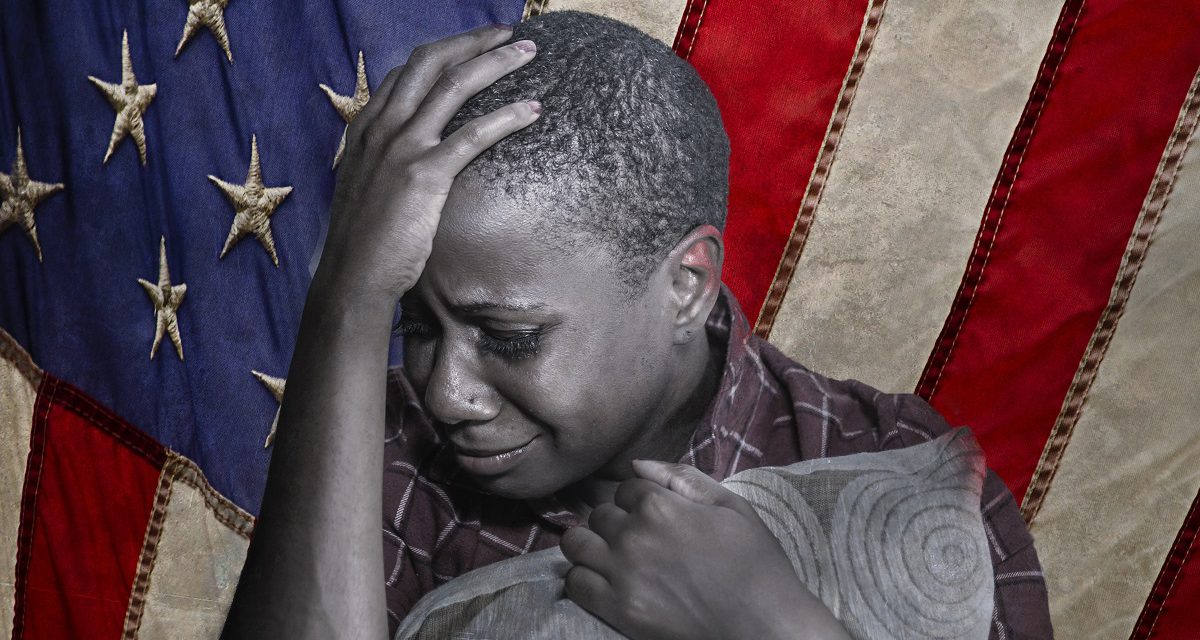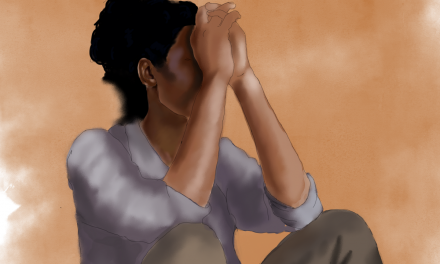According to a 2019 FBI report, hate crimes are at their highest level in a decade and Black people are the most targeted group. Racism, from subtle microaggressions to overt acts of violence, leaves both a mental and physical impact that can transcend not only lifetimes, but generations. Dr. Steven Kniffley Jr., clinical psychologist, describes racism as, “Use of power and privilege at the individual, institutional, and cultural levels to oppress culturally diverse individuals, based on perceived biological inferiority characteristics.” Racism is an instrument of power that’s used to force marginalized people to adhere to their oppressor’s culture and stipulations. Those who step outside of said values are punished in the form of racism and discrimination.
Race-based traumatic stress (RBTS) is an injury on an individual’s mental and physical health and is perpetuated by racism. Mental Health America describes racial trauma as, “the mental and emotional injury caused by encounters with racial bias and ethnic discrimination, racism, and hate crimes.” MHA states that any person who experiences a sudden, uncontrollable racist encounter is at risk of developing RBTS. Racial trauma can be inflicted from one individual to another or it can be the result of an entire system.
Acts of racism and discrimination are not always clearly identifiable, especially by those who don’t often experience race-based prejudice against them. Covert racism (as opposed to overt racism) is often described through the lens of microaggressions. Dr. Derald Wing Sue, of Colombia University, describes racial microaggressions as the, “everyday insults, indignities, and demeaning messages sent to people of color by well-intentioned white people who are unaware of the hidden messages being sent to them.” A microaggression is additionally defined as a verbal, behavioral, or environmental indignity, intentional or unintentional, that communicates negative and hostile slights toward a marginalized individual. Within these microaggressions, there are variants that include microinsults, microassaults, and microinvalidations.
Forms of Racism
A microinsult conveys rudeness and insensitivity toward a person’s racial and cultural heritage, such as telling a person of color that they are a credit to their race. An example of a microassault, on the other hand, resides mostly within a system as a whole rather than on the individual level. For example, policies within educational institutions and the workplace that forbid styles of hair unique to afro-textured hair and Black people is an example of a systemic microassault. The way Black people style and upkeep their hair is deemed unprofessional and distracting by people outside of the Black community, so it is banned. Microassaults and microinvalidations are more explicitly racist but not as overt as being called the N-word. A microinvalidation constitutes phrases such as, “I don’t see color,” and “If you don’t like it here, go back to your country.” Furthermore, microaggressions, specifically microinvalidations, are a form of psychological gaslighting as they make people question their own experiences as people of color when their trials are constantly downplayed or denied acknowledgement of existence.
Microaggressions are just one avenue by which Black people are inflicted with RBTS. At the forefront, the extrajudicial killings of Black men, women, and children at the hands of police is an example of vicarious racism, which Dr. Kniffley describes as a significant form of race-related stress. Constant circulation of videos of police violence, such as the Eric Garner and George Floyd videos, through the mainstream news cycle and social media perpetuate racial trauma and experiences of vicarious racism. Black people endure other instances of stress, perpetuated by institutionalized racism, through the school-to-prison pipeline and high incarceration rates, medical racism, real estate redlining, and job discrimination. Racial trauma interferes with people’s ability to maintain healthy relationships, focus on school and work, and feel safe. For example, Black people in desperate need of emergency assistance might be hesitant to dial 911 for fear of police escalation resulting in injury, false imprisonment, or death.
Facing discrimination daily creates a chronic level of race-related stress which can develop into trauma as well as health complications. Psychological and emotional trauma is the result of stressful events that go beyond an individual’s ability to cope, as it disintegrates one’s sense of security, causes a person to feel inadequate, and lose their sense of purpose. Furthermore, while trauma often constitutes a threat to one’s life or safety, it can be the result of any situation that causes intense feelings of isolation. Instances that result in trauma include one-time events – such as an assault, car accident, or sudden death of a loved one – and ongoing stress. Racial trauma falls into the latter category.
Racial Trauma’s Impact
RBTS has a more significant impact than everyday stress due to three factors. First, everyday instances of racism are paired with vicarious racism. Race-related stress is also chronic; racial bias is placed on people of color from the time they are born until they pass and is passed along through generations. Its ongoing nature possesses a sociohistorical emphasis as racism toward Black and Brown people spans throughout history and is part of their generational narrative as well as part of systems still actively creating stress for people of color such as education, health care, and the criminal justice system.
Because race-related stress spans not only lifetimes but generations, Black people are likely to have chronically elevated cortisol levels and higher instances of post-traumatic stress disorder (PTSD) which can result in poor health outcomes, some of which can be passed along to children. Excess levels of cortisol can cause hostility, chronic fatigue, sleep deprivation, depression, hunger, migraines, and more. The combination of emotional trauma due to lifelong racism and being physically rundown from excess cortisol creates an opportunity where people may turn to unhealthy coping methods that can lead to more severe issues like substance use or avoiding personal care altogether. Poor coping skills continue the cycle of the body not being able to recover to its pre-traumatic event baseline, causing physical and mental health problems to worsen. Mothers who have experienced racial trauma can pass down high levels of cortisol to their children and in some cases, excess levels can influence gene expression.
Racial trauma has a plethora of real-life implications, which is why the discussion surrounding it is imperative. Marginalized people lose years of their lives to depression, anxiety, and lack of opportunities spawned by experiences of individual and systemic racism. For example, the Centers for Disease Control and Prevention (CDC) reports that suicide is among the 15 leading causes of death among the Black American population. Additionally, suicide rates among Black males have doubled since 1980 and rates of depression have quadrupled in the past 20 years.
In the medical sphere, the U.S. Department of Health and Human Services (HHS) found that Black people have a lower life expectancy than their white counterparts. Additionally, a 2016 study conducted by the Proceedings of the National Academy of Sciences (PNAS) found that 73% of white medical students held false beliefs about Black people, including the myth that Black people have a higher pain tolerance. The National Institutes of Health (NIH) reports that Black people are 10% less likely to be admitted into the hospital than whites and 1.36 times more likely to die inside the emergency department. Finally, the Black American infant mortality rate is 2.3 times that of white people and Black infants are almost 4 times as likely to die at birth than white infants. The New England Journal of Medicine found that low birth weight constitutes 13.2% of Black American births compared to the 4.3% of infants born to white women with low birth weight.
A New Approach to Trauma Care
Because racial trauma is passed down both mentally and physically throughout Black families, it is necessary to intervene and educate about racism and its impact early on. Dr. Kniffley’s Collective Care Center implements a method of racial trauma therapy that pulls from various models to create a comprehensive training that establishes identity, processes racial trauma, and builds skills for navigating future events. PTSD symptoms become difficult to escape over time as they include flashbacks to the event that feel real, intrusive thoughts, inability to concentrate, and other mental illnesses such as depression and anxiety. Trauma restricts proper emotional expression and anger often becomes the most accessible emotion whereas the guilt, shame, or fear caused by chronic racism is more difficult to pinpoint, name, or process.
Trauma-influenced behaviors such as aggression, irritability, poor decision making, and hyperactivity often mimic symptoms of other mental illnesses. Racial trauma therapy is necessary because of how easily it can be misdiagnosed, especially in children. When treating people with trauma-influenced behaviors, Dr. Kniffley suggests approaching with “what happened to you?” versus “what is wrong with you?” Young Black boys especially are often misdiagnosed for ADHD or anger issues as a means of containing and controlling their behavior, rather than exploring emotions that may be lying underneath. Black people need a safe space to have their experiences heard, validated, and explored to prevent further mental and physical health problems.
Because racial trauma assessment tools are not currently mainstream, Dr. Kniffley uses a 12-session format that gradually builds up racial identity before processing through trauma and implementing future tools and coping skills. The first four sessions create an assured sense of self using a racial identity assessment followed by a conversation around their score and various activities including comparing how the patient sees themselves versus how society sees them. The second portion of the module processes racial trauma using a unique version of Cognitive Behavioral Therapy (CBT). Whereas traditionally the patient alternates between accessing the traumatic memory and grounding themselves in the present moment, Dr. Kniffley’s method adds a twist. “Similar to other forms of CBT or trauma-processing therapy, we encourage the client to focus on the narrative connected to their experience of racial trauma, but we also take the third step to help the client depict a different outcome,” he said. “This shows their resiliency and ability to overcome that situation. We spend so much time on what happened and not enough time exploring what could be for the client.”
People who have experienced trauma often seek to regain control in various ways, including repressing or denying the truth or entirety of the event. As Dr. Kniffley explains, the chronic nature of racism, knowing that not only societal peers but societal institutions actively create and contribute to racism, creates a sense of hopelessness. Implementing a new sense of racial identity and a new idea of “what could be” while processing racial trauma allows patients to understand what is happening to them and empower them through future hardships. The final four therapy sessions focus on understanding that racial trauma will continue, acquiring tools to navigate racist interactions effectively, and building healthy coping skills to handle racial trauma and race-related stress.
Clients process the traumatic memory through a narrative writing exercise, process the narrative, and create a co-narrative that includes components of resiliency and overcoming future situations. This may include microinterventions or educating offenders of microaggressions on their harmful actions and disarming the situation, and how to seek out affirming spaces where they will be supported. They also learn racial literacy skills which help them identify situations as racist and navigate them successfully.
“I am because you are, you are because I am”
Dr. Kniffley’s racial trauma work draws inspiration from several sources, including the South African philosophy Ubuntu: “I am because you are, you are because I am.” Dr. Kniffley says that racial trauma can cause isolation and make us feel alone but Ubuntu reminds us that we are never alone and there are others out there who share our experience and will share that pain and suffering with us. Dr. Kniffley’s trainings and resources have helped Black people reintegrate into society after being incarcerated, overcome substance use and other dangerous coping mechanisms, navigate predominantly white workplaces, and more. His trainings for school staff help them understand racial trauma by providing real world scenarios while trainings for students explore microaggressions and other commonplace forms of racism.
“If we’re looking to support folks who have experienced race-based trauma, we can help them feel seen and to be seen for their authentic selves and not for the narratives that are often times placed on them,” he said. Learn more about Dr. Kniffely’s racial trauma services and more resources through the Collective Care Center here: https://behavioralhealth.spalding.edu/collaborative-care-clinic-healing-racial-and-intersectional-trauma/
This article was co-written by Tempest Wright and Elena Cleaves.








